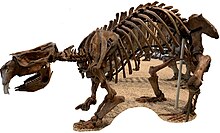| Phascolonus Temporal range: Pliocene–Late Pleistocene PreꞒ Ꞓ O S D C P T J K Pg N | |
|---|---|

| |
| Fossil cast at the American Museum of Natural History | |

| |
| Life restoration | |
| Scientific classification | |
| Domain: | Eukaryota |
| Kingdom: | Animalia |
| Phylum: | Chordata |
| Class: | Mammalia |
| Infraclass: | Marsupialia |
| Order: | Diprotodontia |
| Family: | Vombatidae |
| Genus: | †Phascolonus Owen, 1872 |
| Species | |
| |
| Synonyms | |
| |

Phascolonus is an extinct genus of giant wombat known from the Pliocene and Pleistocene of Australia. There is only a single known species, Phascolonus gigas, the largest wombat ever known to have existed, estimated to weigh as much as 200 kg (450 lb) or 360 kg (790 lb). It was described by Richard Owen in 1859. Phascolomys magnus is a probable junior synonym. P. gigas is distinguished from other wombats by its strap-shaped upper incisors. The cranial roof also is noticeably inwardly depressed. The species was abundant across Australia, with remains having been found in all states except Western Australia. It is suggested to have had a preference for arid and semi-arid inland habitats, with a diet consisting of a high amount of low quality vegetation. Though it likely had wide home-ranges, it probably did not stray far from fresh water sources. Abundant remains have been found in Pleistocene aged deposits from Lake Callabonna in South Australia. Unlike its living relatives, it is unlikely that Phascolonus engaged in burrowing. Phascolonus disappeared during the Late Pleistocene Quaternary extinction event around 50-40,000 years ago, together with many other large Australian animals, following the arrival of humans to the Australian continent. Phylogenetic analysis suggests that is closely related to the other giant wombat genera Ramsayia and Sedophascolomys.
References
- Louys, Julien (3 July 2015). "Wombats (Vombatidae: Marsupialia) from the Pliocene Chinchilla Sand, southeast Queensland, Australia". Alcheringa: An Australasian Journal of Palaeontology. 39 (3): 394–406. doi:10.1080/03115518.2015.1014737. ISSN 0311-5518.
- Long, John A.; Archer, Michael; Flannery, Tim & Hand, Suzanne (2002). Prehistoric Mammals of Australia and New Guinea: One Hundred Million Years of Evolution. University of New South Wales Press. pp. 161–162. ISBN 978-0-8018-7223-5. OCLC 49860159.
- ^ Louys, Julien; Duval, Mathieu; Beck, Robin M. D.; Pease, Eleanor; Sobbe, Ian; Sands, Noel; Price, Gilbert J. (November 2022). Hautier, Lionel (ed.). "Cranial remains of Ramsayia magna from the Late Pleistocene of Australia and the evolution of gigantism in wombats (Marsupialia, Vombatidae)". Papers in Palaeontology. 8 (6). doi:10.1002/spp2.1475. hdl:10072/420259. ISSN 2056-2799.
- ^ Dawson, Lyndall (January 2006). "An ecophysiological approach to the extinction of large marsupial herbivores in middle and late Pleistocene Australia". Alcheringa: An Australasian Journal of Palaeontology. 30 (sup1): 89–114. doi:10.1080/03115510609506857. ISSN 0311-5518.
- Woolnough, Andrew P.; Steele, Vernon R. (March 2001). "The palaeoecology of the Vombatidae: did giant wombats burrow?". Mammal Review. 31 (1): 33–45. doi:10.1046/j.1365-2907.2001.00077.x. ISSN 0305-1838.
- Hocknull, Scott A.; Lewis, Richard; Arnold, Lee J.; Pietsch, Tim; Joannes-Boyau, Renaud; Price, Gilbert J.; Moss, Patrick; Wood, Rachel; Dosseto, Anthony; Louys, Julien; Olley, Jon; Lawrence, Rochelle A. (18 May 2020). "Extinction of eastern Sahul megafauna coincides with sustained environmental deterioration". Nature Communications. 11 (1): 2250. doi:10.1038/s41467-020-15785-w. ISSN 2041-1723. PMC 7231803. PMID 32418985.
- Owen, Richard (1858). "Odontology". The Encyclopedia Britannica, or Dictionary of Arts, Sciences and General Literature. Vol. 16 (Eighth ed.). pp. 447, 450, figure 80.
- Stirling, Edward Charles & Zietz, Amandus Heinrich Christian (1899). "Preliminary notes on Phascolonus gigas, Owen [Phascolomys (Phascolonus) gigas, Owen] and its identity with Sceparnodon ramsayi Owen". Transactions of the Royal Society of South Australia. 23: 123–135 – via BHL.
- "Phascolonus gigas". The Recently Extinct Plants and Animals Database. Retrieved 14 September 2022.
- "It's a wombat, but not like you know it…". South Australian Museum. 13 May 2022. Retrieved 14 September 2022.
| Vombatiformes | ||||||||||||||||||||||||||||
|---|---|---|---|---|---|---|---|---|---|---|---|---|---|---|---|---|---|---|---|---|---|---|---|---|---|---|---|---|
| ||||||||||||||||||||||||||||
| 
 | |||||||||||||||||||||||||||
| Taxon identifiers | |
|---|---|
| Phascolonus | |
This article about a prehistoric marsupial is a stub. You can help Misplaced Pages by expanding it. |